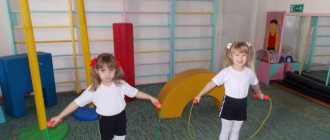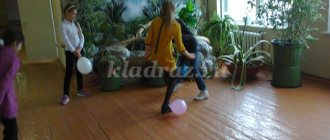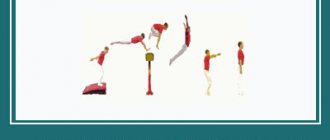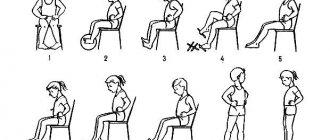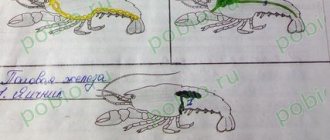Be careful
so UNT / Preschool education / Conceptual foundations of physical education and development of girls of preschool age
Rhythmic gymnastics complex No. 1
06.04.2013 10639 0
Rhythmic gymnastics complex No. 1
Surprise. I. p.: o. With. 2 stamps with the right foot with simultaneous two claps in front of you, 2 side steps to the right. Same to the left. The same with clapping in front and behind you. The same with replacing clapping with rotational movements of the hands in front of the chest (“like starting a motor”). The same with moving your arms forward (2 times) and up to the sides.
Cold-hot.
I. p.: stand up, hands at the shoulder joints. 1- half squat, arms turning the body to the right, head to the right; 2-i. n. The same to the left.
Bend over.
I. p.: stand up, hands on your belt. 1- tilt to the right, arms up, right foot on toe to the right; 2-i. p. Also to the left.
Catch a snowflake.
I. p.: the same. 1- raise your right leg bent at the knee, turning to the right, clap in front of you; 2-i. n. The same to the left.
Turn around.
I. p.: stand, feet shoulder-width apart, arms to the sides. 1- turn to the right, right leg in a half-squat, hands on the waist; 2-i. n. The same to the left.
Archery.
I. p.: o. With. 1-4 – steps forward, starting from the right leg, arms bent at the elbows, hands at the head performing rotations left and right; 5-8 - the left straight arm is to the side - in front, and the right arm performs 3 flexions and abductions back to the shoulder. The same in the opposite direction.
Penguin.
I. p.: stand, feet shoulder-width apart, hands on your belt. 1- bend forward, reach the floor with your hands; 2- arms back, bend over.
Hurry up to change it.
Same thing. 1- jump the right leg bent at the knee forward, the left straight leg back; 2-i. n. The same on the other leg.
Come up with a dance.
Improvisation to music.
Pinocchio.
I.p.: sit on the floor, bend your knees, support your hands behind you. 1-2 – turn, release your knees to the right to the floor; 3-4 - the same to the left.
Lower your legs and raise them.
I. p.: sit down, leaning forward, hands on the toes. 1-2 – transition to a lying position with emphasis on the forearm, raise straight legs forward and up; 3-4 – i. P.
Knees right, left.
I. p.: sit on the floor, bend your knees, support your hands behind you. 1-2 - turn, lower your knees to the right on the floor; 3-4 - the same to the left.
Reach out.
I. p.: sit on the floor, legs apart as wide as possible, arms forward and to the sides. 1-2 - bend forward, reach your toes with your hands; 3-4-i. P.
Goby.
I. p.: kneel with emphasis on your hands in front. Rotate on your legs and arms around yourself to the right, to the left.
Swing.
I.p. lie on your stomach, hands with palms under your chin. 1-6 - grab your shins with your hands, bend and sway, 7-8 and. P.
Let's rest.
I. p.: sit cross-legged, hands on knees. Relaxation 45 sec.: 1-4- straighten your legs forward, arms across the sides pointing at the back (inhale), 5-8- and. n. (exhale).
Rhythmic gymnastics complex No. 2
I. p.: o. With. 1- right hand on the belt; 2- left too; 3- right to the shoulder; 4- left too; 5- right up; 6- left too; 7-8 - clapping overhead; 9-16 - actions are performed in reverse order, clapping on the thighs.
I. p.: o. With. 1- half-squat your hands to your shoulders; 2- hands forward, stand up; 3- hands to shoulders, half squat; 4- arms to the right with the body turned to the right; 5- half squat, hands to shoulders; 6- arms to the left, with the body turning to the left.
I. p.: stand up, hands on your belt. 1- move your right leg to the right, half squat on the left, arms to the sides; 2-i. n. The same with the left leg.
I. p.: the same. 1-2 - half squat, lean forward, move your arms back; 3-4-i. P.
I. p.: o. With. 1-2 - stand on your left leg, raising your right leg bent at the knee and resting it on the shin of your left leg, swinging your arms up and down.
I. p.: the same. 1 - step to the right, half-squat on the right leg, bring the left half-bent leg back behind the right, turn to the left with a clap at waist level; 2- the same in the other direction.
I. p.: stand up, hands on your belt. 1-3- 3 adjustable side canter steps to the right; 4- half squat on the right leg, turn to the left with half-bent arms spread to the sides, left leg heel forward. Same to the left.
Dance fragment: 4 movements, connecting the thumb with the rest of the connected fingers (“ducks open and close their beak”), while the hands are above the shoulders; 4 movements with arms bent at the elbows up and down (“ducks flap their wings”), 4 movements up and down with turning the body to the right and left with alternately lowering and raising the shoulders; 4 claps in front of you, circling in pairs in one direction and the other.
I. p.: sit down on the floor, supporting yourself with your hands behind you. 1-2 - jump to a lying position on the floor; 3-4-i. P.
I. p.: sit on the floor, supporting yourself with your hands behind you. 1- raise your straight right leg forward and up; 2-i. P.; 3-4 - the same with the left foot.
I.p.: Lie on your back, hold your legs bent at the knees with your hands. 1- straighten your legs up, arms to the sides; 2-i. P.
I. p.: sit on the floor, bend your knees, support your hands behind you. 1-2 - turn, lower your knees to the right on the floor; 3-4 - the same to the left.
I. p.: kneel with emphasis on your hands. 1- bend over, swing your straight right leg back; 2-i. P.; 3-4 - the same with the left foot.
I. p.: lie on the floor, hands under your chin. 1-2 - bend over, support on straight arms, legs bent at the knees, reach your head.
I. p.: sit down, legs apart as wide as possible, supporting yourself with your hands behind you. 1- bend towards the right leg, reach the toe with your hands; 2-i. P.; 3-4 - the same to the left leg.
I. p.: sitting, legs crossed, back semicircular, head tilted forward, hands on knees. Relax in this position with your eyes closed for 45 - 60 seconds.
Rhythmic gymnastics complex
№3
1. I.p.: o.s.1 - right hand up from the shoulder; 2- I.p., 3-4 – the same. 5,6,7,8 – the same with the left hand; 9 – arms to the sides, 10 – arms in front of the chest; 11-12 – the same.
2. I.p. Same. 1- bend your left arm at the elbow, right leg at the knee and connect them; 2 – i.p.; 3-4 the same with the left and right foot.
3. I.p. Same. 1- arms forward, then up, bringing the hands together; 2- I.p., 3 – half squat, move your right hand to the right, turning your body to the right, left hand forward; 4 – i.p. Also to the left.
4. I.p. Same. 1 – 3 steps forward with the right foot; 4 – place your left foot next to your right foot with a stomp and a simultaneous clap in front of you; 5–8 the same is performed separately, the same is performed to the right and to the left.
5. I.p. Same. 1 – sit down, hands in front on the floor; 2 – straighten your legs without taking your hands off the floor; 3 – sit down; 4 – stand, arms to the sides, palms up, fingers spread, right leg to the right on the heel (iron), head tilted to the right. Also to the left.
6. I.p.: o.s.1 - bend your arms, bring them together, crossing them in front of your head, tilt your head down, half-squat; 2- i.p.; 3 – bend back, head and arms back; 4- i.p.; 5 – move your right arm to the right, half squat, tilt your head to the right; 6 – i.p.; 7 – 8 the same to the left.
7. I.p.: o.s.1 - jump on the left leg, the right leg (with an iron) to the right simultaneously with the body turning, arms bent at the elbows, palms out, fingers spread; 2 – jump in IP; 2 – 4 – the same to the left.
8. Spin with jumps in pairs, holding hands, in one direction and then in the other direction. Run in place and slow down.
9. IP: sit on your heels, hands down. 1- 4 - bend forward, head down on your knees, hands on the floor in front, 5 - 8 - kneel, bend back, arms to the sides - up.
10. I.p.: sit on the floor, straight legs brought together. 1 - bend the right leg at the knee and pull it towards you, the right arm, bent at the elbow, with fingers spread apart, is moved to the thigh, and the left one is stretched forward in the same position, the head is tilted to the left; 2 – the same on the other leg.
11. I.p.: lie down with emphasis on the forearm. Make circular movements with your knees bent. The same in the opposite direction.
12. I.p.: lie on your back. Various movements with legs and arms. Turn onto your stomach.
13. I.p.: lie on your stomach, hands with palms under your chin. 1 – 2 – spread your arms to the sides, bend over; 3 - 4 - i.p.
14. I.p.: relaxation, lying on your back (45 seconds), then sit down, clasping your arms bent at the knees, lowering your head. 1 – 4 – bend back, arms through the sides back to the floor – inhale; 5 – 8 – i.p. – exhale. Get up and start walking.
Rhythmic gymnastics for preschool children
Modern exercises to music with movements for children are a set of various sports exercises performed at different tempos to melodic works. Rhythmic gymnastics (RG) is based on exercises that are understandable to kindergarten students. They are selected based on the age criteria of preschool children, as well as their level of physical fitness.
Charging with music
Movements to music are aimed at developing coordination. To the accompaniment of children's songs for exercise, the children perform the techniques demonstrated in advance by the teacher. They learn to control the body, navigate in space, strengthen the body and muscles. RG has one nuance - there are no repetitions or cyclic exercises. Due to this, exercises are varied every day, and as a result, preschoolers do them with pleasure.
What does it mean and what advantages does it have?
According to standards, the daily routine in kindergarten begins with morning gymnastic exercises. They must be performed after receiving students and before breakfast.
Note! One cannot have a negative attitude towards RG (ignore it), since it is the most important element in the chain of physical development of children.
Systematic exercise before noon is beneficial for the body in general and improves immunity. The older generation remembers how in the morning the melody of “Pionerskaya Zorka” invited Soviet children to gymnastic exercises. Pioneers and Octobrists practiced to music and instructions from an announcer. Gymnastics in the USSR has always been a mandatory component of the daily routine of kindergartens and pioneer camps.
Children enjoy performing the movements
Today the traditions are being revived, since all children like to jump to the tune. However, exercise with music today has been improved and supplemented with gaming and educational complexes. The advantages of RG are as follows:
- strengthening the body, increasing the immune system, especially if children exercise outside;
- respiratory system training;
- strengthening internal organs, the musculoskeletal system, normalizing metabolic processes.
Many parents are interested in why they need to study to the melody. It's simple - it entertains preschoolers. Most pieces for children's musical fitness are in a major mode and activate positivity in preschoolers. At the same time, music helps in solving various problems in conducting a lesson.
Note! A fun warm-up helps you remember movements faster and perform them from memory. Exercises for children with music and movements will involuntarily make them love playing sports.
How does music help?
Ideally, restorative RG is performed after sleep, but today children cannot always work out with their parents at home. An invigorating workout is possible only in 24-hour kindergartens, which operate 24 hours a day, where children stay for five days. This kind of musical fitness makes it possible to cheer up, improve muscle tone and set children up for learning. Music for exercises in kindergarten without words has the following functionality:
- Call for charging and finishing actions. The backing track helps students navigate when to start a lesson and when it’s time to stop. It can be problematic for kids to perform the movements recited by the teacher, so it is better to accompany gymnastics exercises with preschoolers 1.5–4 years old with music.
- Setting the pace for exercise. Children intuitively know how to march, jog, race, etc. And they do it synchronously. It is easier for preschoolers to study by listening to a melody than by focusing on the movements of the group members.
- Indication of the peculiarities of movements. Melodic playback involves smooth playback, while fast playback provides acceleration.
- Children's songs for exercise lead to expressive performance of exercises; the children strive to do them not memorized, but accelerated.
- Development of creative abilities. Music accompanies children everywhere: at home and in preparation for kindergarten. Preschoolers learn to listen and understand it with and without words, in lessons with a teacher, during the preparatory process for events, entertainment, and in a theater studio. Understanding the melody comes with time. Exercise develops a sense of rhythm, the ability to recognize the intonation of a melody emotionally.
- Health-improving effect. Cheerful rhythmic melodies invigorate, prevent fatigue and the development of negativity.
Complex of morning exercises for the 2nd junior group
For your information! Melodies, among other things, have a positive effect on the development of the pupils’ intelligence.
Peculiarities
Features of rhythmic gymnastics in a preschool institution. Gymnastics should be carried out in a ventilated and clean room. Children's clothes should be comfortable. Usually this is a T-shirt and shorts; shoes and leg warmers are put on your feet; it is very important that the shoes do not slip.
High-quality and daily performance of rhythmic gymnastics contributes to the comprehensive physical development of the child. It has a beneficial effect on the entire body, relieves stress, increases endurance, and improves mood. Freedom of movement and ease of execution, as well as positive emotions - all this is a mandatory guarantee of successfully performed rhythmic gymnastics.
